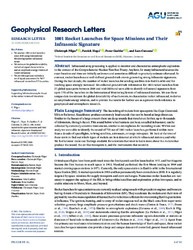1001 Rocket Launches for Space Missions and Their Infrasonic Signature
Pilger, Christoph; Hupe, Patrick; Gaebler, Peter; Ceranna, Lars, 2021: 1001 Rocket Launches for Space Missions and Their Infrasonic Signature. In: Geophysical Research Letters, Band 48, 8, DOI: 10.23689/fidgeo-4260.
 |
Dokument öffnen: |
Infrasound array processing is applied to monitor and characterize atmospheric explosions in the context of the Comprehensive Nuclear‐Test‐Ban Treaty. Anyhow, for many infrasound sources the exact location and time are initially unknown and sometimes difficult to precisely estimate afterward. In contrast, rocket launches are well‐defined ground‐truth events generating strong infrasonic signatures. During the last decade, the number of rocket launches for sending satellites into Earth’s orbit and for reaching space strongly increased. We collected ground‐truth information for 1001 rocket launches from 27 global spaceports between 2009 and mid‐2020 and were able to identify infrasound signatures from up to 73% of the launches on the International Monitoring System of infrasound stations. We use these unique data to estimate the global detectability of such events, to characterize rocket infrasound, to derive an amplitude‐energy relation, and to provide the results for further use as a ground‐truth reference in geophysical and atmospheric research. Plain Language Summary:
The launching of rockets from spaceports like Cape Canaveral, USA or Baikonur, Kazakhstan produces extremely loud sounds that can be heard at large distances. Similar to the basses of a large concert there are deep sounds that travel even farther, up to thousands of kilometers, through the air. This sound below what humans can hear, so called infrasound, can be collected by extremely sensitive instruments, similar to microphones for recording music. Within our study we were able to identify the sound of 733 out of 1001 rocket launches, performed within more than a decade of spaceflights, to bring satellites, astronauts, or cargo into space. We look at the tone of these starts to find out which types of rockets are best detected at which infrasound stations; and why. We furthermore make our findings available for scientists that want to learn more about the rockets that produce the sound, the air that transports it, and the instruments that record it. Key Points:
We analyze 1001 rocket launches since 2009 using International Monitoring System infrasound arrays.
We estimate the global detectability, individual signal characteristics, and an amplitude‐energy relation of rocket infrasound.
We provide a ground‐truth data set of signal parameters for 7637 infrasound events from 733 launches.
Statistik:
ZugriffsstatistikSammlung:
This is an open access article under the terms of the Creative Commons Attribution‐NonCommercial License, which permits use, distribution and reproduction in any medium, provided the original work is properly cited and is not used for commercial purposes.

